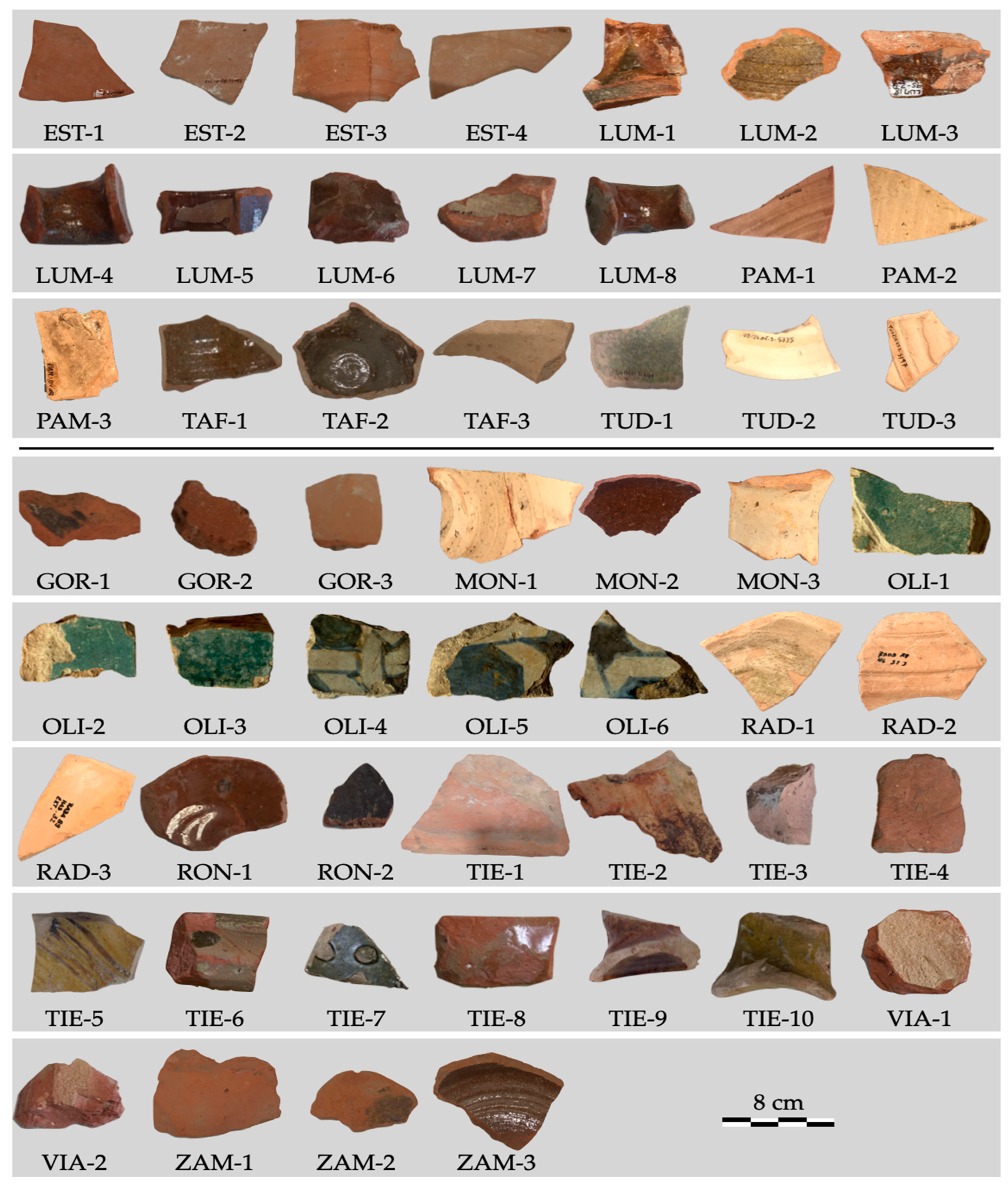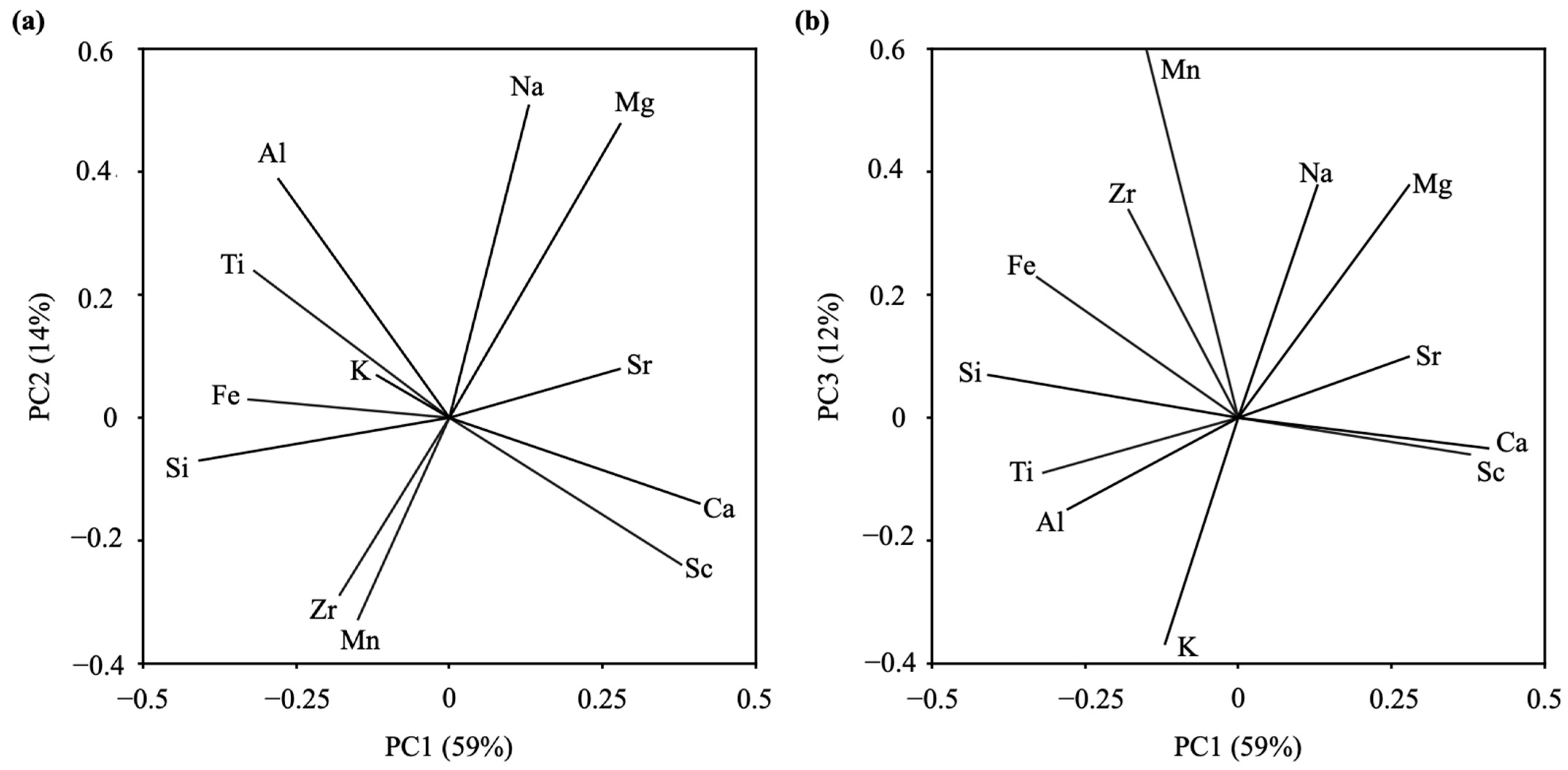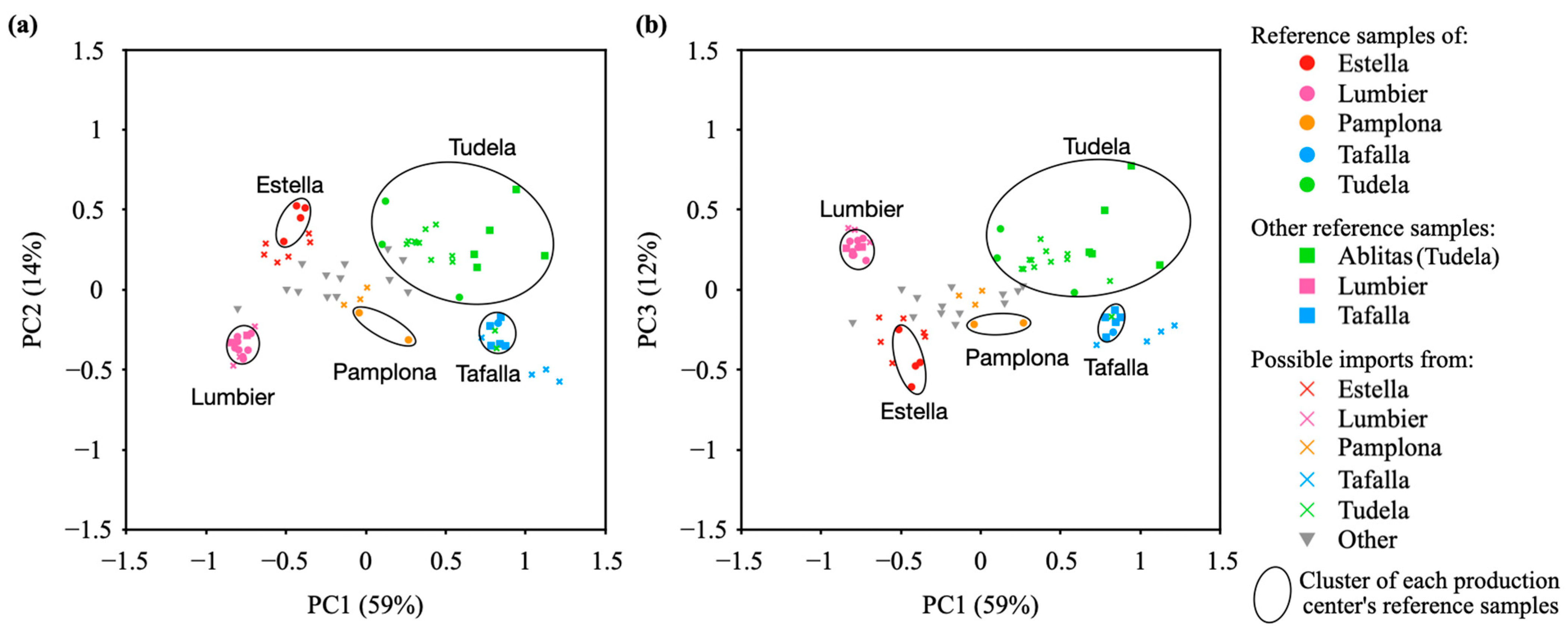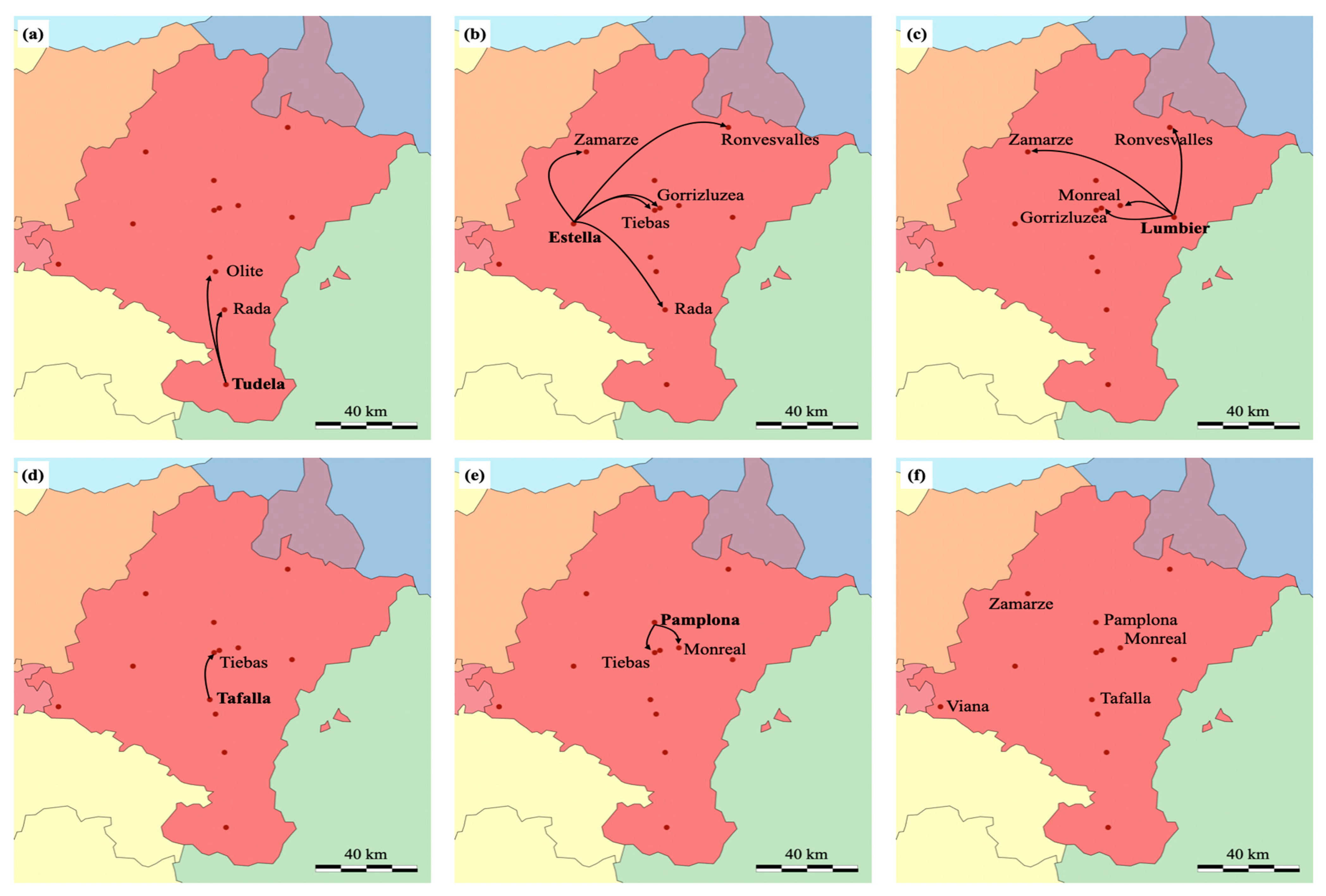The Ceramic Production and Distribution Network in the Ancient Kingdom of Navarre (Spain) during the 12th–15th Centuries
Abstract
1. Introduction
1.1. Geographical and Historical Context
1.2. Ceramic Production in Navarre
1.3. Previous Studies
1.4. Geology and Clay Source Provenance
2. Materials and Methods
2.1. Materials
| ID | Site | Coordinates | N | Type | Chronology | References |
|---|---|---|---|---|---|---|
| EST | Estella | 42.669° N, 2.028° W | 4 | Pottery | XII–XV | [18] |
| LUM | Lumbier | 42.652° N, 1.308° W | 8 | Pottery | XII–XV | [30] |
| PAM | Pamplona | 42.818° N, 1.646° W | 3 | Pottery | XII–XIII | [10] |
| TAF | Tafalla | 42.528° N, 1.674° W | 3 | Pottery, bricks | XII–XV | [11] |
| TUD | Tudela | 42.063° N, 1.608° W | 3 | Pottery | XII–XV | [4] |
| GOR | Gorrizluzea | 42.704° N, 1.621° W | 3 | Pottery | XII–XIII | - |
| MON | Monreal | 42.705° N, 1.510° W | 3 | Pottery | XIII–XV | - |
| OLI | Olite | 42.482° N, 1.650° W | 6 | Tiles | XV | - |
| RAD | Rada | 42.341° N, 1.616° W | 3 | Pottery | XII–XIV | [31] |
| RON | Roncesvalles | 43.010° N, 1.320° W | 2 | Pottery | XII–XV | - |
| TIE | Tiebas | 42.697° N, 1.638° W | 10 | Pottery, bricks | XIII–XV | [32] |
| VIA | Viana | 42.515° N, 2.371° W | 2 | Pottery | XII–XV | - |
| ZAM | Zamarze | 42.923° N, 1.963° W | 3 | Pottery | XII–XV | [33] |
2.2. Methods
3. Results
3.1. PCA Coefficient Matrix (V)
3.2. PCA Scores Matrix (U)
3.3. Mineralogical Composition
4. Discussion
4.1. Production Centres
4.2. Distribution Network
4.3. Navarrese Cultural Diversity
5. Conclusions
Supplementary Materials
Author Contributions
Funding
Data Availability Statement
Acknowledgments
Conflicts of Interest
References
- Fortún-Pérez de Ciriza, L.J.; Floristán-Imizcoz, A. Navarra, Los Límites del Reyno; Gobierno de Navarra: Pamplona, Spain, 2008. [Google Scholar]
- Aznar-Auzmendi, J. El estudio de la cerámica medieval en Navarra. Un estado de la cuestión. Cuad. Arqueol. Univ. Navar. 2022, 30, 163–228. [Google Scholar] [CrossRef]
- Bienes, J.J. Introducción al estudio de la cerámica musulmana de la ciudad de Tudela. Turiaso 1987, 7, 115–158. [Google Scholar]
- Zuazúa, N.; García-Barberena, M.; Unzu, M.; Zuza, C. Memoria de la intervención arqueológica en el número 12 de la calle Herrerías de Tudela. Trab. Arqueol. Navar. 2015, 27, 7–62. [Google Scholar]
- Pérez–Omeñaca, M.C. Excavaciones de urgencia. fase II de la plaza de la Judería (Tudela). Trab. Arqueol. Navar. 2002, 16, 163–173. [Google Scholar]
- Silván, L. Cerámica Navarra, 1st ed.; Graficas Izarra: San Sebastián, Spain, 1973. [Google Scholar]
- Ozaki, A. El régimen tributario y la vida económica de los mudéjares de Navarra. Príncipe Viana 1986, 47, 437–484. [Google Scholar]
- García–Barberena, M.; Unzu, M.; Zuazúa, N.; Zuza, C. Pueblo Viejo de Caparroso, campañas de excavaciones arqueológicas 2016 y 2017. Trab. Arqueol. Navar. 2017, 29, 243–249. [Google Scholar]
- Bienes, J.J.; Sola, O.; Soto-Uriz, N. Yacimiento romano de San Gregorio, Ribaforada. III campaña de excavación. Trab. Arqueol. Navar. 2020, 31/32, 315–322. [Google Scholar] [CrossRef]
- Faro, J.A.; García-Barberena, M.; Unzu, M. Pamplona y el Islam. Nuevos testimonios arqueológicos. Trab. Arqueol. Navar. 2008, 20, 229–283. [Google Scholar]
- Jusué, C.; Tabar, M.I. La cerámica medieval navarra. I. Producción no vidriada. Trab. Arqueol. Navar. 1988, 7, 273–318. [Google Scholar]
- Molera, J.; Carvajal-López, J.C.; Molina, G.; Pradell, T. Glazes, colourants and decorations in early Islamic glazed ceramics from the Vega of Granada (9th to 12th centuries CE). J. Archaeol. Sci. Rep. 2018, 21, 1141–1151. [Google Scholar] [CrossRef]
- Vieira Ferreira, L.F.; Casimiro, T.M.; Boavida, C.; Costa Pereira, M.F.; Ferreira Machado, I. An Archaeometric Study of Lead-Glazed Medieval Ceramics (13th–14th Century) from Santarém, Portugal. Heritage 2024, 7, 2217–2238. [Google Scholar] [CrossRef]
- Holmqvist, E.; Heinonen, T.; Vaisanen, R.; Pihlman, A.; Koivisto, A.; Russow, E. Ceramic fabrics and lead glazes of late medieval redware pots in the Helsinki, Turku and Tallinn regions (ED-XRF, SEM-EDX). J. Archaeol. Sci. Rep. 2020, 34, 102627. [Google Scholar] [CrossRef]
- Savage, G. Majolica in Western Pottery. Britannica Enciclopaedia. Pottery—Majolica, Glazing, Ceramics|Britannica. Available online: https://www.britannica.com/art/pottery/Majolica (accessed on 19 August 2024).
- Hualde, F. Alfarería en Lumbier, 1st ed.; Lamiñarra: Pamplona, Spain, 2013. [Google Scholar]
- Muruzábal, J.M. Alfarería de Estella: Cuchareros de los Echeverría. Cuad. Etnol. Etnogr. 2017, 91, 43–67. [Google Scholar]
- Ramos-Aguirre, M. Intervenciones arqueológicas en el castillo de Estella (2001–2010). Trab. Arqueol. Navar. 2015, 27, 185–218. [Google Scholar]
- Amadori, M.L.; Cardellini, S.; Mengacci, V. Advances in lead-barium-zinc-silicate-type glazed warming bowl related to the Chinese Xuande Reign (1426–1435). Heritage 2024, 7, 1496–1509. [Google Scholar] [CrossRef]
- Polvorinos, A.; Aucouturier, M.; Bouquillon, A.; Castaing, J. The evolution of lustre ceramics from Manises (Valencia, Spain) between the 14th and 18th centuries. Archaeometry 2011, 3, 490–509. [Google Scholar] [CrossRef]
- Tite, M.S. Ceramic production, provenance and use—A review. Archaeometry 2008, 2, 216–231. [Google Scholar] [CrossRef]
- Mapa Geológico de Navarra (Memoria y Mapa); Gobierno de Navarra, Departamento de Obras Públicas, Transportes y Comunicaciones, Servicio de Obras públicas: Pamplona, Spain, 1997.
- Ruiz-Ardanaz, I.; Gil-Fernández, M.; Lasheras, E.; Durán, A. Revealing the manufacturing technology to produce the unique carreaux de pavement found in the Iberian Peninsula. Appl. Clay Sci. 2023, 231, 106725. [Google Scholar] [CrossRef]
- Papachristodoulou, C.; Gravani, K.; Oikonomou, A.; Ioannides, K. On the provenance and manufacture of red-slipped fine ware from ancient Cassope (NW Greece): Evidence by X-ray analytical methods. J. Archaeol. Sci. 2010, 37, 2146–2154. [Google Scholar] [CrossRef]
- Gajić-Kvaščev, M.D.; Marić-Stojanović, M.D.; Jančić-Heinemann, R.M.; Kvaščev, G.S.; Andrić, V.D. Non-destructive characterisation and classification of ceramic artefacts using pEDXRF and statistical pattern recognition. Chem. Cent. J. 2012, 6, 102. [Google Scholar] [CrossRef]
- Maltsev, A.S.; Pashkova, G.V.; Fernández-Ruiz, R.; Demonterova, E.I.; Shuliumova, A.N.; Umarova, N.N.; Shergin, D.L.; Mukhamedova, M.M.; Chubarov, V.M.; Mikheeva, E.A. Characterization of archaeological ceramics from eastern Siberia by total-reflection X-ray fluorescence spectrometry and principal component analysis. Spectrochim. Acta Part B At. Spectrosc. 2021, 175, 106012. [Google Scholar] [CrossRef]
- Longoni, M.; Calore, N.; Marzullo, M.; Teseo, D.; Duranti, V.; Bagnasco Gianni, G.; Bruni, S. Bucchero Ware from the Etruscan Town of Tarquinia (Italy): A Study of the Production Site and Technology through Spectroscopic Techniques and Multivariate Data Analysis. Ceramics 2023, 6, 584–599. [Google Scholar] [CrossRef]
- Neff, H. Theory, Sampling, and Analytical Techniques in the Archaeological Study of Prehistoric Ceramics. Am. Antiq. 1993, 58, 23–44. [Google Scholar] [CrossRef]
- Gliozzo, E. Ceramics investigation: Research questions and sampling criteria. Archaeol. Anthropol. Sci. 2020, 12, 202. [Google Scholar] [CrossRef]
- Ramos-Aguirre, M. Excavaciones en la ciudad romana de Ilumberris (Lumbier, Navarra). Cæsaraugusta 2007, 78, 521–534. [Google Scholar]
- Tabar, M.I. Actividad Arqueológica en Navarra 1988–1989. Trab. Arqueol. Navar. 1992, 10, 435–436. [Google Scholar]
- Ramos-Aguirre, M. Excavaciones en el castillo de Tiebas (Navarra), primer informe provisional. Trab. Arqueol. Navar. 1998, 15, 167–214. [Google Scholar]
- Armendariz, R.; Mateo, M.R. Santa María de Zamartze (Uharte–Arakil). Trab. Arqueol. Navar. 2009, 21, 293–315. [Google Scholar]
- Bienes, J.J.; Sola, O. La villa romana de El Villar de Ablitas. Campaña de 2015. Trab. Arqueol. Navar. 2016, 28, 7–14. [Google Scholar]
- Ramis-Ramos, G.; Álvarez-Coque, M.C. Quimiometría; Editorial Síntesis: Madrid, Spain, 2001. [Google Scholar]
- Ruiz-Ardanaz, I.; Úriz-Asiáin, O.; Lasheras, E.; Durán, A. Tiebas Castle’ tuiles vernissées: Characterization, raw clay provenance, and manufacturing technology. Appl. Clay Sci. 2024; Under review. [Google Scholar]
- García Fitz, F.; Gouveia Montero, J. War in the Iberian Peninsula, 700–1600, 1st ed.; Routledge: London, UK, 2018. [Google Scholar]
- Solares, C.C. Social continuity and religious coexistence: The Muslim community of Tudela in Navarre before the expulsion of 1516. Contin. Change 2011, 26, 309–331. [Google Scholar] [CrossRef]
- Ramos, M.; Labé, L.F.; Sánchez, A.C. Arqueología y cultura judaica. Príncipe Viana 2011, 253, 121–133. [Google Scholar]





| Element | PC1 | PC2 | PC3 | PC4 | PC5 | PC6 | PC7 | PC8 | PC9 | PC10 | PC11 | PC12 |
|---|---|---|---|---|---|---|---|---|---|---|---|---|
| Na | 0.13 | 0.51 | 0.38 | −0.44 | −0.08 | 0.01 | −0.42 | 0.08 | 0.09 | 0.42 | −0.13 | 0.02 |
| Mg | 0.28 | 0.48 | 0.38 | 0.50 | 0.18 | −0.25 | 0.16 | 0.09 | −0.29 | −0.18 | 0.20 | 0.10 |
| Al | −0.28 | 0.39 | −0.15 | 0.07 | 0.15 | 0.25 | −0.03 | −0.09 | 0.64 | −0.18 | 0.40 | 0.22 |
| Si | −0.41 | −0.07 | 0.07 | −0.16 | −0.21 | −0.30 | 0.24 | −0.05 | −0.24 | 0.33 | 0.33 | 0.57 |
| K | −0.12 | 0.07 | −0.37 | 0.50 | 0.21 | −0.16 | −0.15 | 0.27 | 0.13 | 0.53 | −0.33 | 0.12 |
| Ca | 0.41 | −0.14 | −0.05 | −0.08 | 0.06 | 0.09 | −0.17 | 0.02 | 0.06 | −0.29 | −0.30 | 0.76 |
| Sc | 0.38 | −0.24 | −0.06 | −0.06 | 0.12 | 0.33 | −0.01 | 0.54 | −0.05 | 0.26 | 0.55 | 0.00 |
| Ti | −0.32 | 0.24 | −0.09 | −0.33 | 0.18 | 0.02 | 0.31 | 0.64 | −0.13 | −0.30 | −0.28 | 0.00 |
| Mn | −0.15 | −0.33 | 0.60 | 0.24 | −0.30 | −0.07 | 0.03 | 0.35 | 0.47 | −0.06 | −0.12 | 0.01 |
| Fe | −0.33 | 0.03 | 0.23 | 0.26 | −0.04 | 0.76 | −0.09 | −0.08 | −0.38 | 0.07 | −0.13 | 0.11 |
| Sr | 0.28 | 0.08 | 0.10 | −0.07 | 0.08 | 0.23 | 0.76 | −0.21 | 0.23 | 0.34 | −0.23 | 0.03 |
| Zr | −0.18 | −0.29 | 0.34 | −0.14 | 0.84 | −0.09 | −0.10 | −0.15 | 0.02 | 0.06 | 0.01 | 0.00 |
| Explained | 59% | 14% | 12% | 5% | 4% | 3% | 2% | 0.8% | 0.8% | 0.7% | 0.3% | 0.01% |
| ID | Si | Ca | Al | Fe | K | Mg | Ti |
| EST | 47 ± 3 | 7 ± 3 | 22 ± 2 | 13.4 ± 0.8 | 6.2 ± 0.8 | 2.2 ± 0.7 | 1.34 ± 0.08 |
| LUM | 54 ± 3 | 2 ± 1 | 19 ± 1 | 16 ± 1 | 4.9 ± 0.7 | 1.7 ± 0.4 | 1.26 ± 0.08 |
| PAM | 40 ± 2 | 20 ± 4 | 17 ± 1 | 12.1 ± 0.8 | 5.2 ± 0.6 | 2.6 ± 0.4 | 1.10 ± 0.06 |
| TAF | 25 ± 3 | 44 ± 5 | 12 ± 1 | 9.9 ± 0.5 | 4.1 ± 0.7 | 2.2 ± 0.5 | 0.86 ± 0.06 |
| TUD | 33 ± 2 | 25 ± 5 | 17 ± 2 | 12 ± 1 | 4 ± 2 | 5.0 ± 0.9 | 1.05 ± 0.08 |
| ID | Na | Mn | Sr | Sc | Zr | ||
| EST | 0.5 ± 0.2 | 0.10 ± 0.04 | 0.11 ± 0.03 | 0.01 ± 0.01 | 0.07 ± 0.05 | ||
| LUM | 0.18 ± 0.09 | 0.32 ± 0.06 | 0.06 ± 0.01 | 0.00 ± 0.01 | 0.14 ± 0.02 | ||
| PAM | 0.3 ± 0.2 | 0.20 ± 0.02 | 0.16 ± 0.04 | 0.08 ± 0.04 | 0.07 ± 0.01 | ||
| TAF | 0.01 ± 0.01 | 0.13 ± 0.01 | 0.29 ± 0.08 | 0.24 ± 0.07 | 0.06 ± 0.01 | ||
| TUD | 0.9 ± 0.4 | 0.19 ± 0.02 | 0.3 ± 0.1 | 0.11 ± 0.04 | 0.06 ± 0.01 | ||
| ID | Q | I | C | H | G | A | D | W |
|---|---|---|---|---|---|---|---|---|
| EST | +++ | ++ | + | ++ | + | – | – | – |
| LUM | +++ | + | – | ++ | – | – | – | – |
| PAM | +++ | ++ | ++ | + | + | – | – | – |
| TAF | ++ | + | +++ | + | +++ | + | – | + |
| TUD | ++ | ++ | ++ | + | ++ | ++ | + | – |
Disclaimer/Publisher’s Note: The statements, opinions and data contained in all publications are solely those of the individual author(s) and contributor(s) and not of MDPI and/or the editor(s). MDPI and/or the editor(s) disclaim responsibility for any injury to people or property resulting from any ideas, methods, instructions or products referred to in the content. |
© 2024 by the authors. Licensee MDPI, Basel, Switzerland. This article is an open access article distributed under the terms and conditions of the Creative Commons Attribution (CC BY) license (https://creativecommons.org/licenses/by/4.0/).
Share and Cite
Ruiz-Ardanaz, I.; Araiz-González, S.; Lasheras, E.; Durán, A. The Ceramic Production and Distribution Network in the Ancient Kingdom of Navarre (Spain) during the 12th–15th Centuries. Heritage 2024, 7, 4814-4828. https://doi.org/10.3390/heritage7090228
Ruiz-Ardanaz I, Araiz-González S, Lasheras E, Durán A. The Ceramic Production and Distribution Network in the Ancient Kingdom of Navarre (Spain) during the 12th–15th Centuries. Heritage. 2024; 7(9):4814-4828. https://doi.org/10.3390/heritage7090228
Chicago/Turabian StyleRuiz-Ardanaz, Iván, Sayoa Araiz-González, Esther Lasheras, and Adrián Durán. 2024. "The Ceramic Production and Distribution Network in the Ancient Kingdom of Navarre (Spain) during the 12th–15th Centuries" Heritage 7, no. 9: 4814-4828. https://doi.org/10.3390/heritage7090228
APA StyleRuiz-Ardanaz, I., Araiz-González, S., Lasheras, E., & Durán, A. (2024). The Ceramic Production and Distribution Network in the Ancient Kingdom of Navarre (Spain) during the 12th–15th Centuries. Heritage, 7(9), 4814-4828. https://doi.org/10.3390/heritage7090228







